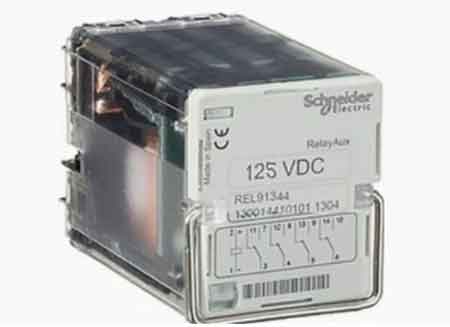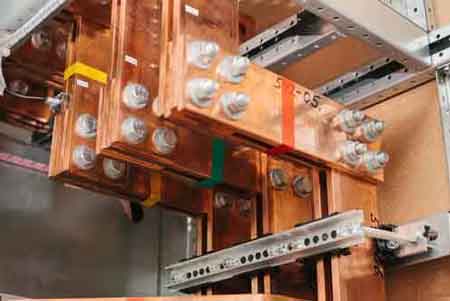Auxiliary Relay In Power Systems

Protective Relay Training - Basic
Our customized live online or in‑person group training can be delivered to your staff at your location.

- Live Online
- 12 hours Instructor-led
- Group Training Available
Download Our OSHA 3075 Fact Sheet – Understanding Electrical Hazards in the Workplace

- Learn the effects of electric current on the human body
- Understand OSHA safety standards and protective devices
- Discover essential lockout/tagout and grounding practices
Auxiliary relay devices support protective relays by extending contact capacity, providing signal amplification, and enabling remote control functions. Common in switchgear and automation, they enhance fault detection, interlocking, and the reliability of electrical protection schemes.
What is an Auxiliary Relay?
An auxiliary relay is a secondary device used in electrical protection and control systems to perform auxiliary switching, signal transfer, contact multiplication, and interlocking functions.
✅ Extends protective relay contact capacity
✅ Enables signalling, alarms, and remote control
✅ Improves flexibility in automation and protection
Unlike protective relays, which detect faults, these devices support control logic by providing additional contacts and signal routing. In ANSI/IEEE standards, the auxiliary or lockout relay is often referred to as device 86.
Basic Protection Relay Training
Request a Free Training Quotation
Functions and Importance
An auxiliary relay is a crucial component in control circuits, designed to assist and extend the functionality of primary relays and control devices. It enables the amplification or duplication of signals within a system, ensuring smooth and efficient operation of complex circuits. By managing switching mechanisms, trip coils, and multiple outputs from a single input, these devices enhance coordination, safety, and reliability.
Types of Auxiliary Relays
Not all auxiliary relays are built the same; different tasks require different operating principles. The most common types are designed to match specific timing and signalling needs.
-
Instantaneous: operate without delay, making them ideal for emergency trip circuits and alarm activation.
-
Time delay: deliberately introduce a lag to allow sequencing or prevent nuisance tripping in motor control or coordination schemes.
-
Latching relays retain their last state until manually or electrically reset, which is valuable for lockout functions and persistent alarm conditions.
-
Heavy-duty relays are designed for demanding environments, featuring higher contact ratings and extended mechanical life for industrial applications.
-
Interposing relays adapt control signals when voltage or current levels differ between devices, ensuring safe interfacing with PLCs or protection circuits.
These categories demonstrate the versatility of these relays, which can be tailored to simple or highly complex protection schemes.
Test Your Knowledge About Electrical Protection!
Think you know Electrical Protection? Take our quick, interactive quiz and test your knowledge in minutes.
- Instantly see your results and score
- Identify strengths and areas for improvement
- Challenge yourself on real-world electrical topics
Technical Specifications
Beyond the type, engineers must pay attention to technical ratings. Each specification influences how the relay behaves in service and whether it can withstand the rigours of continuous operation.
-
The coil voltage must align with the control supply, whether it is AC or DC.
-
Contact rating defines the maximum current and voltage that the contacts can reliably carry, typically 10A at 250V AC for common designs.
-
Operating time and switching speed are crucial in applications such as high-speed tripping.
-
Burden refers to the coil’s power consumption and its impact on the control circuit.
-
Mechanical and electrical life indicate expected durability, often in hundreds of thousands of operations.
-
Environmental resilience ensures optimal performance under extreme conditions, including heat, vibration, moisture, or corrosive environments.
-
Standards compliance with ANSI, IEEE, or IEC provides assurance of quality and safety.
Each of these metrics helps determine the relay’s suitability for a given application and its long-term reliability.
Real-World Applications
They appear in nearly every branch of electrical engineering. Their role is not only theoretical but deeply practical, serving functions that operators depend on daily.
-
In power systems and substations, they manage trip coils, trigger alarms, and distribute protective signals to multiple breakers.
-
In industrial control systems, they sequence motor operations, interlock safety devices, and provide feedback signals to controllers.
-
In telecommunication and automation systems, they route alarm conditions, extend contact functions, and ensure signals reach multiple destinations.
A common example is when a protective relay sends one trip signal. This type of device amplifies this action, allowing multiple circuit breakers to open simultaneously, triggering an alarm, and creating a log entry in the SCADA system.
Wiring and Installation
Correct installation is essential for ensuring reliable relay operation. Engineers must carefully match coil voltage ratings, confirm correct polarity in DC circuits, and wire contacts according to whether they are normally open (NO) or normally closed (NC).
-
Coil terminals are connected to the control supply.
-
NO and NC contacts are wired to trip circuits, alarms, or feedback loops.
-
All connections must be labelled for clarity in control panels.
-
IEC and ANSI/IEEE standards guide safety and installation practices.
-
Testing for continuity and insulation resistance confirms proper setup before energization.
These steps guarantee accurate relay performance and reduce the risk of wiring errors.
Failure Modes and Maintenance
Like any electromechanical device, these devices are prone to wear and environmental stress. Awareness of common failure modes helps engineers maintain reliability.
-
Contact wear or welding occurs after prolonged use or high-current interruptions.
-
Coil burnout occurs due to overvoltage or excessive heating.
-
Contact bounce may cause false signals in sensitive systems.
-
Environmental degradation from dust, moisture, or corrosion weakens performance.
Routine inspections, resistance checks, and functional testing help detect these issues early. Where reduced maintenance is a priority, some operators opt for solid-state relays; however, these may not offer the same level of electrical isolation as electromechanical types.
Auxiliary vs Protective Relays
It is important to distinguish auxiliary relays from protective relays. Protective relays are designed to detect abnormal electrical conditions such as overcurrent, undervoltage, or frequency deviations, and then issue trip commands. They, on the other hand, do not sense faults themselves but extend and distribute the protective relay’s output.
-
Protective relays initiate the decision to trip.
-
They ensure that the decision is implemented across multiple circuits.
Modern systems sometimes use electronic logic or solid-state relays instead of traditional electromechanical designs. These alternatives are faster and reduce mechanical wear, though they may come at a higher cost or with different reliability considerations.
Electricity Today T&D Magazine Subscribe for FREE

- Timely insights from industry experts
- Practical solutions T&D engineers
- Free access to every issue
Comparison of Auxiliary Relay Types
To better understand their roles, the table below summarizes the main types, their functions, and their advantages and limitations.
| Type | Function | Common Use Case | Advantage | Limitation |
|---|---|---|---|---|
| Instantaneous | Immediate switching | Trip circuits, alarms | Fast and reliable | Limited adaptability |
| Time-delay | Controlled delay | Motor sequencing | Adjustable timing | Slightly slower response |
| Latching | Holds state until reset | Lockout, alarms | Memory function | Requires manual reset |
| Heavy-duty | High load endurance | Industrial equipment | Rugged and long-lasting | Larger and more costly |
| Interposing | Matches signal levels | PLC interfacing | Flexible and safe | Adds extra circuit element |
Key Selection Factors
Selecting the right kind requires a balance between technical requirements and operational conditions. Engineers evaluate coil voltage, contact configuration, and contact ratings to ensure compatibility. They also consider the duty cycle, expected lifespan, and the environment in which the relay will operate.
-
Coil and contact ratings must suit the application.
-
Contact configurations should provide the needed NO/NC flexibility.
-
Durability and compliance with standards ensure long-term reliability.
-
Environmental conditions dictate the need for protective measures, ranging from enclosures to coatings.
By weighing these factors, engineers choose relays that deliver dependable service in demanding electrical systems.
These devices may not take the spotlight like protective relays, but their behind-the-scenes contribution is indispensable. By amplifying signals, distributing trip commands, and coordinating multiple outputs, they form the backbone of reliable protection schemes. Whether in substations, industrial plants, or automation networks, their careful selection, installation, and maintenance ensure that electrical systems remain both safe and efficient.
Related Pages








